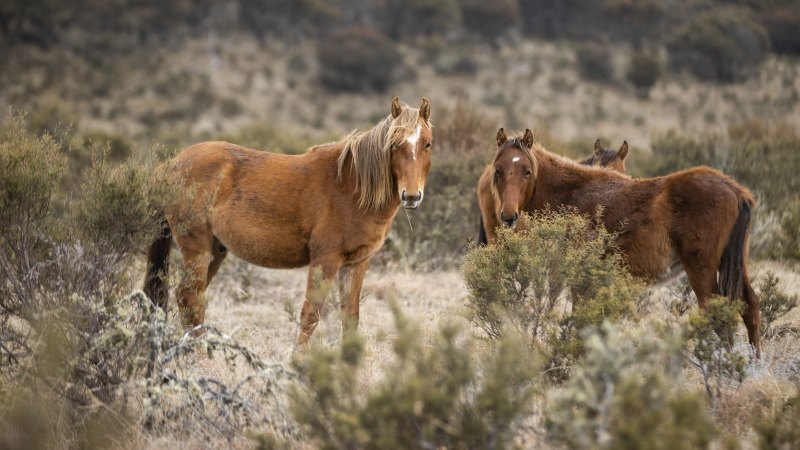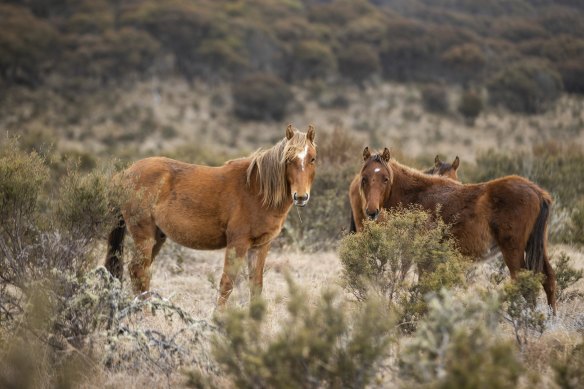Save articles for later
Add articles to your saved list and come back to them any time.
The federal government has been urged to trigger its powers under national laws to push state governments to dramatically reduce feral horses in Australia’s high country, in a split Senate report endorsed by Labor senators.
The majority of the Senate environment committee also called for the Albanese government to boost state funding for the management of the fragile alpine environment.
Ecologists say horse herds must be quickly reduced to prevent the extinction of threatened native species.Credit: Alex Ellinghausen
Significantly, the report called on the NSW government to remove its self-imposed ban on aerial shooting in a bid to reduce the swiftly growing horse population, citing experts who argue that the use of helicopters in culling programmes is needed to achieve wide-scale results.
It also called on the federal government to take a leadership role to help the NSW, Victorian and ACT governments co-operate on improving the degraded ecosystems of the Australian Alps.
“The heritage-listed Australian Alps are under pressure from significant threats. Key among these is the threat posed by feral horses,” the report said.
However, a dissenting report from the three Coalition senators on the inquiry questioned evidence that the horse population was increasing rapidly and rejected the proposed use of aerial culling.
It instead called for fertility control, mustering and trapping, exclusion fencing and ground culling, citing horses’ association with European settlement as one reason a reduced number should remain in the Alps.
“Brumbies have also co-existed with humans, and a multitude of other animal and plant species, for over 200 years,” the dissenting report said.
“By complete contrast, in the course of this inquiry and in the majority report, the Australian brumby has instead been routinely depicted as a pest inflicting undesirable and untold damage throughout the region.”
ACT independent senator David Pocock, who initiated the inquiry, said the federal government must impose tougher environmental standards for states to comply with to save the alpine environment, which is unique on the Australian continent.
He also said federal funding to the states must be boosted, given the Albanese government had committed only $200,000 to the management of alpine areas to date, and argued that feral horses had no place in protected areas.
“Horses are amazing animals. There is so much of Australia where they can live, but national parks shouldn’t be one of those places because all these other native species have nowhere else to go,” Pocock said.
Federal Environment Minister Tanya Plibersek said she was considering the report’s findings. She welcomed the call to remove horses from the Alps but did not say whether she endorsed aerial culling or increased Commonwealth funding.
“I want feral horses removed from the Australian Alps. They damage our fragile alpine and sub-alpine ecosystem. That’s why the government supported the establishment of this inquiry,” Plibersek said.
“I will continue to work with all the powers of the Commonwealth and collaboratively with the states and territories to ensure that the precious plants and animals that call the Alps home are preserved for our kids and grandkids.”
The federal government’s threatened species scientific committee told the inquiry that horse numbers must be quickly reduced to prevent the extinction of up to 12 native species, including the stocky galaxias fish and the corroboree frog, and to halt damage to the fragile ecosystem.
But advocates for the horses, who champion the history and romance of the brumbies, argue against culling on animal welfare grounds and are calling for the horses to retain a presence in Kosciuszko.
NSW’s Kosciuszko Wild Horse Heritage Act banned aerial culling in the state under a peace deal brokered between former environment minister Matt Kean and former Nationals leader John Barilaro, following a stoush within the former Coalition government over the issue.
There are 18,800 horses in Kosciuszko National Park, NSW’s portion of the Alps, and the population has increased about 30 per cent in the past two years. There is no ban in Victoria but aerial culling has never been undertaken. There are an estimated 2500 horses in Victoria’s portion of the Alps.
NSW Environment Minister Penny Sharpe, who is currently considering public submissions to a separate inquiry into the state’s aerial culling ban, welcomed the Senate committee findings, which she said “confirm the concerns NSW has about the impact of wild horses on the Kosciuszko National Park”.
Invasive Species Council advocacy manager Jack Gough hopes the Senate report pushes state and federal governments to approve the controversial technique and increase funding for the management of the Alps.
“With governments at all levels backing feral horse control, we are optimistic, but unless aerial shooting is approved by Minister Sharpe, and federal Minister Plibersek is prepared to stump up serious funding, all this talk will not make a difference to the rapidly rising feral horse population,” Gough said.
Cut through the noise of federal politics with news, views and expert analysis. Subscribers can sign up to our weekly Inside Politics newsletter.
Most Viewed in Politics
From our partners
Source: Read Full Article


